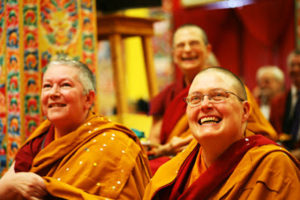

When the Buddha began to teach, the natural response from those most moved, was to give up the household and step forth into monastic life. The Buddha advocated the importance of this choice, not as the only option for those seeking liberation but as part of the four-fold sangha: fully ordained monks, nuns; male and female lay followers. This stable basis would enable the teachings to remain a living tradition wherever it becomes established.
The relationship between lay sangha and monastics is one of mutual benefit.
In reliance upon material support and respect from the lay sangha, monastics can progress, dedicating themselves to full-time study and practice so they may quickly become well trained and capable of spiritually guiding the lay community, whom in turn benefit.
As Buddhism expands and takes root in new countries we see the arising of the fourfold sangha in keeping with the Buddha’s intent. Where this presence is strong, then the teachings can flourish.
Everywhere the love of pleasure is destroyed,
The great dark is torn apart,
And death,
You too are destroyed.
– Therigatha [Sela], Verses of the Elder Nuns from the Pali Canon c. 600 BC
Any Doubts?
If we didn’t answer all of your questions, feel free to drop us a line anytime.



